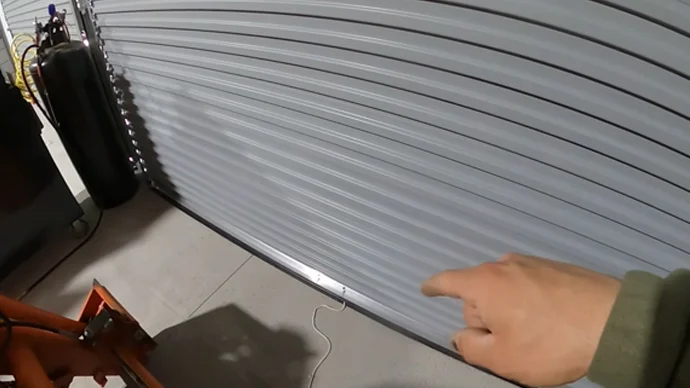Industrial and commercial buildings constructed from metal are durable, low maintenance, and available in various designs. But they need to be accurately attached to the concrete foundation, which is a significant consideration. These buildings can be subject to water infiltration, leaks, and other problems if not adequately sealed.
Sealing the building to the concrete foundation helps to create a water-tight barrier that inhibits moisture from seeping in. Also, sealant helps to prevent rust and corrosion, potentially extending the life of the building. But how to seal the metal buildings to concrete to prevent water infiltration and air gaps?
When your metal building does not adhere well to the concrete, moisture can seep in, causing microbes and mildew, both harmful to your health and your properties. Check out the post to know how to seal your metal building to concrete and prevent these issues.
How to Seal Metal Building to Concrete to Prevent Damages?
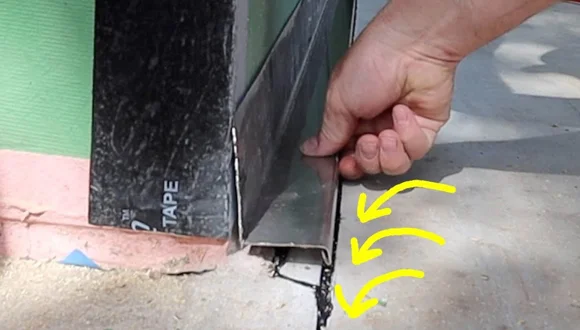
Sealing a metal building to concrete is essential to prevent water or moisture damage. Water can seep under the minor cracks and crevices, causing Rusting from the inside out. To seal the building, you must follow these steps:
Step 01. Choose a High-Quality Sealant
When choosing a sealant, ensure it is compatible with wall panels and concrete. You should also consider the climate conditions of your area to pick the proper sealant.
If you live in an area with high humidity, consider opting for a waterproof sealant, or if you reside in a place with extreme temperatures, opt for a sealant that can withstand hot and cold weather.
Caulks made from synthetic rubber can be used on various surfaces, but they are particularly effective when applied to metal or masonry surfaces. It is also possible to protect against heavy rainfall and high humidity with these products. Over time, they can degrade and counteract the sealant’s efficacy.
Alternatively, silicone sealant and polyurethane sealant can be used to produce a flexible, water-tight seal once cured. When storing foodstuffs, you may be able to use a caulking sealant that is water-based, low-toxic, and VOC-compliant.
Step 02. Prepare the Surface
Before applying the sealer, the surface must be immaculate and free of contaminants. The easiest way to achieve this is to use a high-pressure power washer or air blower. Start by removing loose debris, such as dirt, rotten leaves, or small stones.
Then direct the power washer at the surface, using a wide fan spray pattern. Move the wand back and forth across the surface until evenly cleaned.
If there are stubborn areas of dirt or grime, scrub them with a stiff brush before rewashing the entire surface. Once the surface is cleaned, allow it to dry completely before proceeding.
Step 03. Apply the Sealant Around the Base
It is time to apply the sealant. Use a caulk gun to apply a bead of glue around the base of the building. Start at one corner and work your way around, maintaining a consistent width. Use masking tape to create a straight line.
As you go, keep an eye out for any cracks or gaps in the sealant. If you find any, apply another layer of sealant over the top. Once you have finished applying the sealant, remove the masking tape and dispose of it properly.
Step 04. Spread it evenly with a Finger or Roller
As soon as you have completed the whole circle, smooth the bead with a finger or a roller. Be sure to clean up any excess sealant immediately, as it can be difficult to remove once it dries. Allow the sealant to dry for 24 hours before placing anything on or against the surface.
After the sealant has dried, you can inspect it to ensure no gaps or cracks if everything looks good. Congratulations, you have successfully sealed the metal building to the concrete and prevented water damage.
Following these steps can help you protect your investment for years to come by ensuring a water-tight seal.
What is the Best Sealant to Seal Metal Buildings to Concrete?

Caulks and sealants are the most common materials used to fill in gaps and seal off areas that need to be waterproof or weatherproof. Caulks are typically made of rubber or silicone and are designed to flex with the movement of the building. Sealants are usually made of asphalt or tar and are intended to harden and create a watertight seal.
Both caulks, and sealants can effectively seal the joint between a metal building and concrete. There are many different types of caulks and sealants available, but one type of caulk often used for sealing metal buildings’ bases to concrete is silicone caulk (such as Butyl rubber caulk).
Silicone caulk is highly flexible and is particularly well-suited for metal and masonry, making it ideal for use in areas that experience a lot of movement or expansion and contraction. But, silicone caulk can be difficult to apply evenly and eventually deteriorate and need to be replaced. Also, it is not always compatible with other coatings or finishes.
Another type of sealant that is sometimes used for metal buildings is urethane foam sealant (AKA spray foam insulation or expanding foam sealant). This sealant is more flexible than silicone caulk but is also much more challenging to apply. Also, some sealants create a more permanent bond, but they are hard to remove if they need to be repaired or replaced.
So, it is essential to carefully consider the project’s needs before choosing a caulk or sealant. In most cases, caulks will provide sufficient protection against moisture and pests, but a sealant may be necessary for projects that require extra durability.
Why Should Metal Buildings Be Sealed to Concrete?
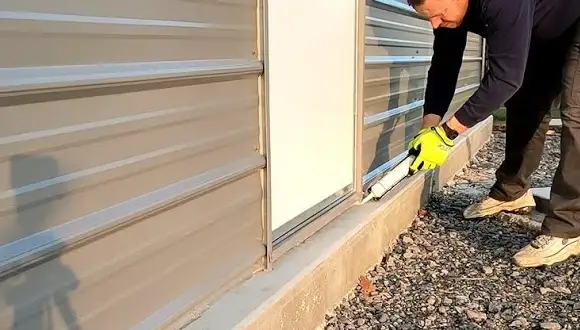
Metal buildings are typical on metal construction sites but can also be found in various other settings, from industrial warehouses to storage sheds. One of the most important things to remember when erecting a metal building system is to seal the base to the concrete slab foundation.
If this step is not taken, several problems can occur. Also, unsealed buildings’ belongings are more susceptible to moisture damage, as the metal panels can quickly become dislodged.
Here are some reasons why you should take the time to seal your metal building:
You Might Want to Check: What’s the best way to tile over sealed concrete?
To Prevent Water Damage
Metal buildings are long-lasting and low-maintenance, but they can be vulnerable to water damage if they are not adequately sealed to the concrete foundation. It is possible for water to penetrate the metal walls and cause rusting and corrosion to your indoor machinery.
In extreme cases, the metal may even start to break down. To prevent water damage, seal the gap between the metal building and the concrete slab foundation.
Reduce Rust and Properties Degradation
Metal buildings that are not adequately sealed to concrete can suffer from rust and other forms of degradation. Rust occurs when oxygen and water come into contact with the metal, causing it to break down. This process can be accelerated by the presence of salt, which is often used to de-ice roads and sidewalks in winter.
Over time, rust can cause the metal to weaken and eventually collapse. Also, unsealed metal buildings’ belongings can suffer from condensation, leading to the growth of spores. By sealing the metal to the concrete, you can help to prevent these problems and extend the life of your building.
To Prevent Wind Damage
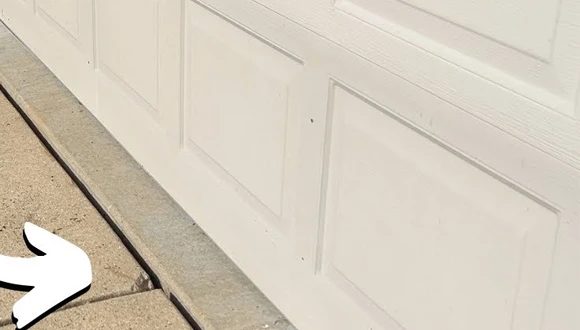
Sealing the metal building will create a barrier protecting the interior from wind damage. By creating a weather-tight seal, you can significantly reduce the risk of wind-blown debris causing damage to your building’s inner accessories.
Also, sealing metal buildings with concrete slabs can help to reduce noise levels and improve energy efficiency.
Reduce Weakens Metal Structures
Metal buildings are often sealed to the concrete slab to reduce weak metal structures of inner accessories. This is done by attaching the metal building to the concrete with special fasteners and aluminum trim, which prevents the metal from coming into contact with the concrete and rusting.
Prevent Pests Damage
Metal buildings are fire-resistant, but one potential downside of metal buildings is that they can be susceptible to damage from pests. Termites, carpenter ants, and other insects can chew through the metal siding, causing significant damage.
Also, rodents can gnaw on wires and insulation, creating a fire hazard. To protect metal buildings from pests, it is essential to seal the structure’s base to concrete. This creates a barrier that pests cannot penetrate, preventing them from gaining access to the building.
Prevent Uncomfortable Indoor Conditions
Unsealed metal buildings can be drafty and uncomfortable due to the cold air entering through structural gaps. By sealing the building to concrete, you can mitigate these issues and create a more comfortable indoor environment.
Also, sealing will help to reduce energy costs by preventing heat loss. So, sealing your concrete building with metal is crucial in ensuring a comfortable and healthy indoor environment.
You can prevent all these problems by sealing gaps between metal buildings and concrete foundations. Also, sealing will help to improve indoor air quality. So, don’t forget to seal your metal building when you erect it.
What Can You Put Between Concrete and Metal Before Seal?

There are a few things that you can put between concrete and metal to seal the two surfaces and prevent water or air seepage, such as:
Watertight Expansion (EMSEAL)
Between concrete and metal, there are many ways to protect the area from weathering and water damage. One way is to use a product called EMSEAL. Emseal is a flexible, two-part sealant applied between concrete or metal surfaces.
It forms a durable, weather-resistant barrier that helps to prevent water and moisture from penetrating the surface. Emseal is also UV resistant, so it will not fade or deteriorate over time. Also, it is easy to apply and can be used on both horizontal and vertical surfaces.
Aluminum Trim
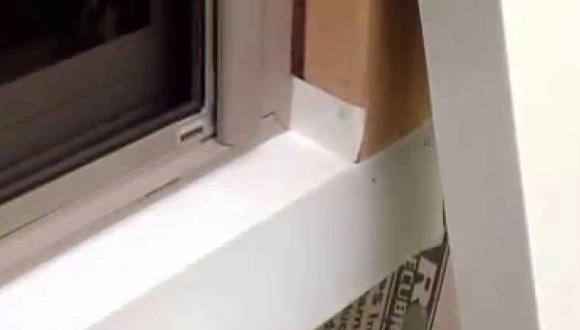
Before sealing, use aluminum trim between concrete and metal before applying the sealant. This is because aluminum trim is relatively inexpensive and easy to find. Plus, it does a great job of creating an airtight seal.
Unlike other materials, aluminum trim can withstand high temperatures and will not deteriorate over time.
The trim provides a physical barrier that helps to keep water and moisture out while also providing a surface for the sealant to adhere to. Also, the trim distributes any forces applied to the joint, making the sealant less likely to fail.
Is it OK to Seal Metal Buildings to Concrete?
Most people are familiar with seeing a metal building on a concrete pad. This is a common arrangement for everything from storage sheds to office buildings. They are solid and sturdy, making them ideal for applications such as warehouses and storage units.
But, one question often arises about whether metal buildings should be sealed to concrete. The short answer is yes, it’s perfectly fine to do so. There are several benefits to sealing metal buildings to concrete.
It helps to create a tight seal between the two surfaces, preventing moisture and pests from entering the building. Also, it helps to insulate the building, keeping it cooler in the summer and warmer in the winter. So if you’re looking for a way to protect your metal building, sealing it to concrete is a great option.
